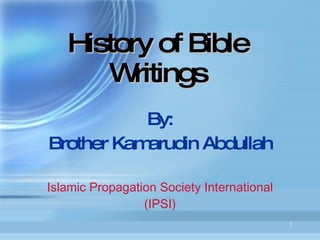History Of Bible Writings
- 1. History of Bible Writings By: Brother Kamarudin Abdullah Islamic Propagation Society International (IPSI)
- 2. Bible has been written and re-written several times over a period of many centuries. 3300 years ago the absolute original Torah must have been in Hebrew language which is a sister language of Arabic. But it was reduced to writing some 200 years after Moses. 2000 years ago the absolute original Gospel must have been in Aramaic language which was also sister language of Arabic. But it was reduced to writing some 40 to 100 years after Jesus. Islamic Propagation Society International (IPSI)
- 3. 3. 200 years after Moses, the Torah was first composed. In it were included the Ten Commandments, Songs, some prophetic sayings of Prophet Jacob & Moses & some legislative religious text. 4. Then Royal Jewish writers kept on adding. 5. 300 years after Moses, YAHVISTIC version of Bible appeared. Islamic Propagation Society International (IPSI)
- 4. 350 years after Moses ELOHISTIC version of Bible appeared. 500 years after Moses the Books of Amos, Hosea Michah & Deuteronomy were added to YAHVISTIC version of Bible (Torah). 580 years after Moses a SECER-DOTAL version also appeared. Now there were 3 parallel versions. Islamic Propagation Society International (IPSI)
- 5. 9. 700 years after Moses-amalgamation of YAHVISTIC, ELOHISTIC & SECER-DOTAL versions took place. 10. 725 years after Moses, Book of LAMENTATIONS was added. 11. 750 years after Moses, Books of ZEPHANIAH, NAHUM, HAGGI, ZECHARIA, ISAIAH, MALACHI & DANIEL were added. Islamic Propagation Society International (IPSI)
- 6. 12. 820 years after Moses, Book of PROVERBS was added. 13. 850 years after Moses, Book of JOB was added. 14. 1000 years after Moses, Jewish scholars of Alexandria decided to rewrite the text of Torah out of the existing various texts in one language â Greek. 70 scholars rewrote it therefore this version is known in history as SEPTUA-GINT. Islamic Propagation Society International (IPSI)
- 7. 15. 1000 years after Moses, Book of ECCLESIASTES was added. 16. 1100 years after Moses, Books of CHRONICLES, EZRA & NAHEMIAH were added. 17. 1300 years after Prophet Moses came Prophet Jesus. Islamic Propagation Society International (IPSI)
- 8. 18. 15 A.D. 23 Books of Paul & of other writers appeared though Paul & those others who wrote the Epistles were not equal to prophets. Yet their writings are included in the Bible. 19. During 40 â 100 A.D. hundreds of Gospels appeared. 20. 325 A.D. only 4 Gospels out of many were retained by King Constantine of Constantinople (now Istanbul). Islamic Propagation Society International (IPSI)
- 9. 21. 700 A.D. This time a Latin version appeared called the VULGATE version (by now YAHVISTIC ELOHISTIC, SECER-DOTAL & VULGATE versions had appeared). 22. 1605 A.D. Pope Clement VIII accepted the VULGATE version. Others were rejected. 1870 A.D. Vatican Council again revised the Bible. 1962 A.D. Second Vatican Council again revised it. Islamic Propagation Society International (IPSI)
- 10. 25. 1978 A.D. Some 100 scholars from world over took the task to scrutinize & revise the Bible text & called it â Holy Bible-New International Version. 26. 1983 A.D. Before the ink was dry, it was again revised. Islamic Propagation Society International (IPSI)
- 11. 27. Thus there were a number of Bible texts YAHVISTIC ELOHISTIC, SECER-DOTAL & VULGATE versions. Because they were multilingual & complicated, therefore their authenticity was questionable. Hebrew, Arabic, Latin, Syriac, Greek & even Arabic versions were in use. The fusion of all these texts & languages into 1 text certainly created the problem of authenticity. Compromises & adjustments were made in the Canon â the ecclesiastic text. Islamic Propagation Society International (IPSI)
- 12. ( Continuation ) Bible had always remained vulnerable. The human element in writing it is considerable. It has been written arbitrarily over a long period of time adding texts in pieces & bits. Islamic Propagation Society International (IPSI)












